The Kaveri Refresh 'Godavari' Review: Testing AMD's A10-7870K
by Ian Cutress on June 1, 2015 11:59 AM ESTProfessional Performance: Linux
Built around several freely available benchmarks for Linux, Linux-Bench is a project spearheaded by Patrick at ServeTheHome to streamline about a dozen of these tests in a single neat package run via a set of three commands using an Ubuntu 11.04 LiveCD. These tests include fluid dynamics used by NASA, ray-tracing, OpenSSL, molecular modeling, and a scalable data structure server for web deployments. We run Linux-Bench and have chosen to report a select few of the tests that rely on CPU and DRAM speed.
C-Ray: link
C-Ray is a simple ray-tracing program that focuses almost exclusively on processor performance rather than DRAM access. The test in Linux-Bench renders a heavy complex scene offering a large scalable scenario.
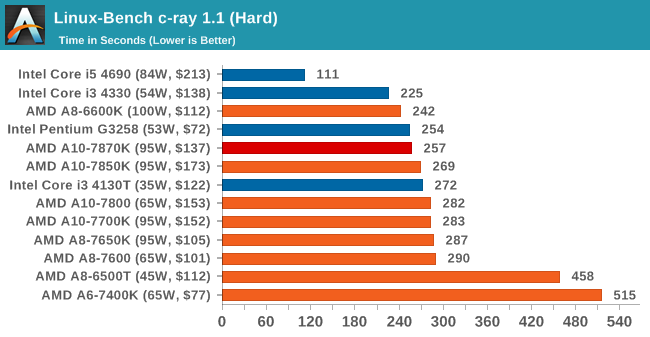
NAMD, Scalable Molecular Dynamics: link
Developed by the Theoretical and Computational Biophysics Group at the University of Illinois at Urbana-Champaign, NAMD is a set of parallel molecular dynamics codes for extreme parallelization up to and beyond 200,000 cores. The reference paper detailing NAMD has over 4000 citations, and our testing runs a small simulation where the calculation steps per unit time is the output vector.
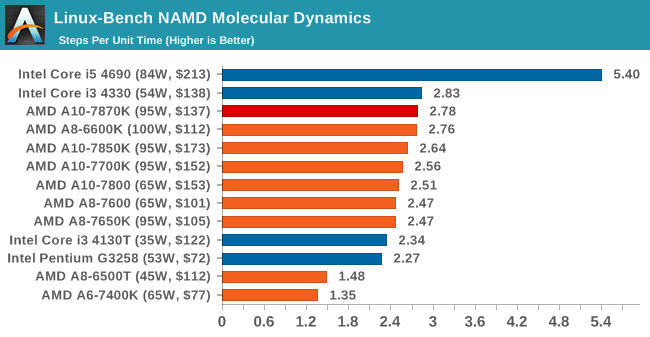
NPB, Fluid Dynamics: link
Aside from LINPACK, there are many other ways to benchmark supercomputers in terms of how effective they are for various types of mathematical processes. The NAS Parallel Benchmarks (NPB) are a set of small programs originally designed for NASA to test their supercomputers in terms of fluid dynamics simulations, useful for airflow reactions and design.
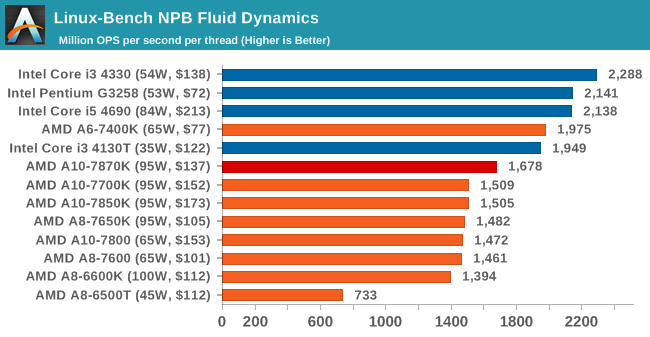
Redis: link
Many of the online applications rely on key-value caches and data structure servers to operate. Redis is an open-source, scalable web technology with a strong developer base, but also relies heavily on memory bandwidth as well as CPU performance.
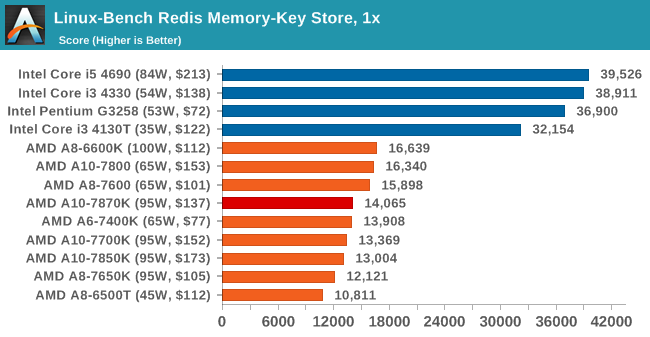

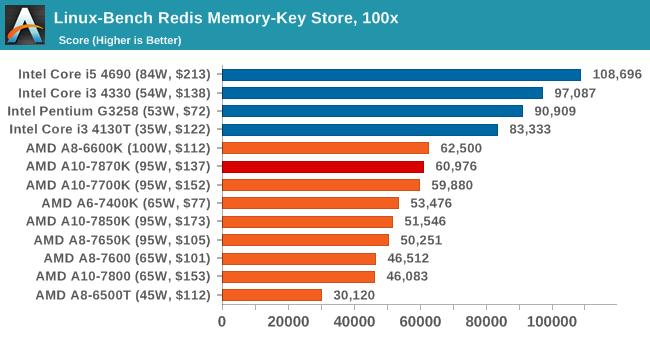










140 Comments
View All Comments
Travis26 - Tuesday, June 2, 2015 - link
AMD seems to have the stock voltages too high a lot of times. My Athlon x4 750k with default settings goes up to 1.45 V for the 4 Ghz turbo boost, but it is perfectly stable at 1.29V and possibly lower. I had to lower the voltage because the temperatures were too high under load with the stock cooler.hallstein - Monday, June 1, 2015 - link
Something is seriously wrong with these numbers. The ordering of the AMD parts seems to be effectively random in many cases. What the hell happened?And the conclusions drawn make no reference to the crazy numbers. I'm a big fan of anandtech's reporting, but I'm sorry to say this article is just about useless as is.
number99 - Monday, June 1, 2015 - link
I agree. Part of the problem may be the need for a new bios for the new cpu (it seems to be throttling), but a lot of the benches don't make sense.silverblue - Tuesday, June 2, 2015 - link
The board in question isn't the same as the one that CPU World used (ASRock FM2A88M Extreme4+). Unless AMD made a large boo-boo pre-release that would affect multiple vendors' BIOS updates, I can't see this affecting the results too much. It may be worth testing on that ASRock board to see what a patched board will do, or perhaps throwing a 7850K into the MSI board to see if the board itself is to blame. It's likely the higher Kaveri models, but the power usage looks rather off as well so it could be the board.I'm waiting on another review which can hopefully shed some light on the performance issues we've been seeing. Perhaps it was really only AT's sample that was causing issues?
Vesperan - Monday, June 1, 2015 - link
I find it interesting that even with a R9 285 or GTX 770 you are quite often GPU bound (at 1080p) rather than CPU bound. If your only concern is gaming (like mine, and likely most here) it reinforces that low(ish) end CPU + high(ish) GPU is best for price-performance. Seems odd you can have such a low performance CPU with such a high performance GPU.mikato - Wednesday, June 3, 2015 - link
Yeah this is what makes AMD chips great options for gamers right now. Very similar performance for much cheaper with a good discrete GPU, and much better performance with integrated GPU.ES_Revenge - Saturday, June 6, 2015 - link
It's not really odd at all, it's the way it has always been for *most* contemporary games and GPUs. Some games do have some 'balance' toward CPUs as well but GPU is still the major player in game performance. Three cores (remember Athlon-II X3?) or two cores plus hyper threading, and clock around 3Ghz or faster (depending on what CPU it is) is enough CPU for most modern games. And, unless you are aiming for really high framerates in SLI/Crossfire, PCI-e 1.1 x16 is also enough for single-card gaming. These things have been proven time and time again, yet lots of people like to talk about or imagine "bottlenecks" that just don't exist.You can have a R9 280X or GTX 770 on a Yorkfield C2Q and not really be too worse for wear in gaming other than high power consumption/heat, particularly if you're only looking for 60FPS. You'll still have 80-95% of the FPS performance of a modern i5 and the same GPU in most games and if that performance is otherwise in the 100s and you only need 60 Vsync, then the add'l CPU power is doing nothing for you.
Going from a C2D to a C2Q to an i7 all on the same GPU, I can tell you the biggest jump in performance in gaming, came from going from the C2D to the C2Q. Sure a Haswell i7 is going to give some better frame rates than a Clarkdale i3 and the same GPU, but it's not going to be any spectacular leap and if you're not trying to squeeze 130FPS from where you were getting 110FPS previously, you don't care about a faster CPU. And even then you are better off OCing your GPU first, again for most games.
All you really need for decent 60FPS gaming is a fast GPU(s) (fast enough for the res and settings you want to play at) and any ol CPU that is 3 cores/threads or more and a decent clock rate. Not really much more to it than that.
nofumble62 - Tuesday, June 2, 2015 - link
Does it support 4K monitor? If yes, what is the frame rate?anubis44 - Wednesday, June 3, 2015 - link
Ian is English, which means his vocabulary, even if he were only a typical Brit, is about 6 times the size of most Americans. A 'queue' is a line-up. A 'miasma' is a noxious atmosphere or influence. I often think, as a Canadian of British descent, the Americans would have been much better off in a myriad of ways if they'd simply lost the Revolutionary War. They'd likely have universal healthcare, about ~50,000 fewer gun deaths every year, and much bigger vocabularies. They'd also be able to read a grade 9 level English CPU review without having to ask 'WTF' it means.silverblue - Monday, June 8, 2015 - link
Oh, the Americans use the word 'queue', albeit spelt as 'cue', and it's seldom used.